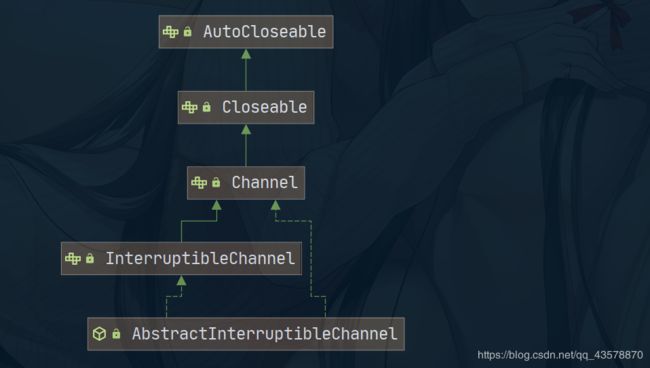JavaNIO-Channel
前言
上一篇分析了Buffer,这一篇继续来分析jdk nio中另一个比较重要的类-Channel。通道可以打开和关闭。
类图
这里只是选取了一部分
Channel
Channel接口仅仅有两个方法。
是否打开和关闭。
public interface Channel extends Closeable {
public boolean isOpen();
public void close() throws IOException;
}
源码中对close方法的描述为:如果channel已经关闭了再次执行close方法是无效的,如果一个线程正在执行close方法,另一个线程同时也执行了close方法,则会阻塞直至第一个线程从该方法返回。实际就是简单的上锁。
InterruptibleChannel
描述:A channel that can be asynchronously closed and interrupted.
可以异步关闭和中断的channel。
关于异步关闭:我的理解是当有线程由于IO操作在channel的方法挂起的时候,另外的线程可以直接关闭这个channel,但是这就需要channel主动通知挂起的线程,让挂起的线程抛出异常返回。
这个接口没有增加任何方法。仅仅起到一个声明的作用。
这个接口对close方法增加了一条描述:
Any thread currently blocked in an I/O operation upon this channel will receive an {@link AsynchronousCloseException}.
任何由于IO中断在这个channel的线程,在另一个线程执行了close方法之后会抛出一个 AsynchronousCloseException并返回。
AbstractInterruptibleChannel
private final Object closeLock = new Object();
private volatile boolean closed;
// -- Interruption machinery --
private Interruptible interruptor;
private volatile Thread interrupted; // 可能需要通知的线程
AbstractInterruptibleChannel.begin
方法描述:Marks the beginning of an I/O operation that might block indefinitely.
为了实现异步中断和异步关闭,这个方法应该在可能要因为IO操作而阻塞之前执行,并且应该通过try finally块与 end()方法同时执行。如果当前线程在将要因为执行IO操作而进入阻塞之前,判断一下线程是否已经被中断了,如果是则及时关闭channel,是十分有必要的。
什么是异步关闭呢?就是随时可以关闭,直接关闭,不管有没有线程正在这个channel上执行IO操作。
贴一下close方法吧
AbstractInterruptibleChannel.close
public final void close() throws IOException {
synchronized (closeLock) {
if (closed)
return;
closed = true;
implCloseChannel();
}
}
protected final void begin() {
// 如果可能要通知的线程为null
if (interruptor == null) {
// 方法内部类
interruptor = new Interruptible() {
// 通知target线程关闭channel
public void interrupt(Thread target) {
synchronized (closeLock) {
if (closed)
return;
closed = true;
interrupted = target;
try {
AbstractInterruptibleChannel.this.implCloseChannel();
} catch (IOException x) { }
}
}};
}
blockedOn(interruptor);
Thread me = Thread.currentThread();
// 如果当前线程被中断了
if (me.isInterrupted())
interruptor.interrupt(me);
}
这个方法的作用是在线程可能会因为IO操作阻塞之前,判断线程的中断标记,如果已经被中断了,那么就要及时关闭channel,否则可能会有内存泄漏的风险。因为线程的中断标记已经为true了,线程随时可能转为其他非running状态。
至于为什么interrupt(Thread target)这个方法要封装到一个内部类,再将引用赋值给线程的一个成员变量,而不是直接写在外面,判断线程如果已经被中断则立即调用这个方法,我想了很久也没搞清楚,将这个方法放在外面明明也可以起到相同的效果呀?
blockedOn(interruptor)最终是调用了Thread.blockedOn(Interruptible b)
/* Set the blocker field; invoked via jdk.internal.misc.SharedSecrets
* from java.nio code
*/
static void blockedOn(Interruptible b) {
Thread me = Thread.currentThread();
synchronized (me.blockerLock) {
me.blocker = b;
}
}
AbstractInterruptibleChannel.end
protected final void end(boolean completed)
throws AsynchronousCloseException
{
blockedOn(null);
Thread interrupted = this.interrupted;
// 看前面的begin方法。
if (interrupted != null && interrupted == Thread.currentThread()) {
this.interrupted = null;
throw new ClosedByInterruptException();
}
// IO操作没有完成,但是别的线程已经关闭了channel
if (!completed && closed)
throw new AsynchronousCloseException();
}
begin和end方法光说可能有点抽象,随便找一个实现类,比如SocketChannelImpl,看看含有IO操作的方法就明白这两个方法有什么用了。
AbstractInterruptibleChannel就分析到这。
SelectableChannel
这是一个比较重要的抽象类,这个接口定义了一种可以基于选择器Seletor进行多路复用的Channel。
类图:

demo
接下来我要完成一个基于jdk NIO服务端的例子,尽管编程方式非常的反人类,但还是写一下吧。
/**
* @author delicious
* @ClassName: MyServer
* @describe 利用jdk NIO 实现的聊天服务器
* @createDate 2020/4/19
*/
@Slf4j
public class MyNioServer {
private final ServerSocketChannel serverChannel = ServerSocketChannel.open();
private Selector selector = Selector.open();
public MyNioServer() throws IOException {
serverChannel.socket().bind(new InetSocketAddress(8888));
serverChannel.configureBlocking(false);
// 将通道和感兴趣的IO事件注册到选择器
serverChannel.register(selector, SelectionKey.OP_ACCEPT);
}
public void start() throws IOException {
for (; ; ) {
// 阻塞直至有感兴趣的并且可以处理的IO事件
selector.select();
log.info("有待处理的io事件!");
// 获得所有可以处理的、已经注册了的IO事件
Set<SelectionKey> keys = selector.selectedKeys();
Iterator<SelectionKey> it = keys.iterator();
while (it.hasNext()) {
SelectionKey key = it.next();
if (key.isAcceptable()) {
SocketChannel channel = serverChannel.accept();
log.info("接受一个连接,生成一个channel");
channel.configureBlocking(false);
// 注册到选择器,这就是多路复用了
channel.register(selector, SelectionKey.OP_READ, ByteBuffer.allocate(1024));
} else if(!key.channel().isOpen()){
log.info("close.");
key.channel().close();
} else if (key.isReadable()) {
log.info("readable...");
// 通过key反向获取channel
SocketChannel channel = (SocketChannel) key.channel();
ByteBuffer byteBuffer = (ByteBuffer) key.attachment();
try {
channel.read(byteBuffer);
} catch (IOException e) {
e.printStackTrace();
channel.close();
}
String s = new String(byteBuffer.array());
log.info("server接收到消息:"+s);
}
it.remove();
}
}
}
public static void main(String[] args) throws IOException, InterruptedException {
MyNioServer server = new MyNioServer();
Thread thread = new Thread(() -> {
try {
server.start();
} catch (IOException e) {
e.printStackTrace();
}
});
thread.start();
SocketChannel channel = SocketChannel.open(new InetSocketAddress(8888));
channel.write(ByteBuffer.wrap("hello world".getBytes()));
thread.join();
}
}
AbstractSelectableChannel.register
public final SelectionKey register(Selector sel, int ops, Object att)
throws ClosedChannelException
{
// 校验ops的值是否合法
if ((ops & ~validOps()) != 0)
throw new IllegalArgumentException();
// 检查channel现在是否以及关闭了
if (!isOpen())
throw new ClosedChannelException();
// 同时只能由一个线程执行此方法
synchronized (regLock) {
if (isBlocking())
throw new IllegalBlockingModeException();
// 该线程需要同时拿到keyLock才嫩继续操作
synchronized (keyLock) {
// re-check if channel has been closed
if (!isOpen())
throw new ClosedChannelException();
SelectionKey k = findKey(sel);
if (k != null) {
// 将传入的对象attach到key,这样之后可以从key取出
k.attach(att);
k.interestOps(ops);
} else {
// New registration
k = ((AbstractSelector)sel).register(this, ops, att);
addKey(k);
}
return k;
}
}
}
我们主要到调用了findKey方法,这个方法遍历该channel所有的keys,如果发现有key对应的选择器是将要注册到的选择器,就直接返回这个key,然后修改一下i感兴趣的事件就可以继续用了,否则就要new一个SelectionKey。
AbstractSelectableChannel.findKey
private SelectionKey findKey(Selector sel) {
// 此时不可能有别的线程修改keys
assert Thread.holdsLock(keyLock);
if (keys == null)
return null;
for (int i = 0; i < keys.length; i++)
if ((keys[i] != null) && (keys[i].selector() == sel))
return keys[i];
return null;
}
SelectionKey.attach
public final Object attach(Object ob) {
return attachmentUpdater.getAndSet(this, ob);
}
SelectionKey.attachmentUpdater
字面意思,专门用来负责对attachment进行原子操作的原子操作类。
private static final AtomicReferenceFieldUpdater<SelectionKey,Object>
attachmentUpdater = AtomicReferenceFieldUpdater.newUpdater(
SelectionKey.class, Object.class, "attachment"
);
发现调用了juc原子操作类 AtomicReferenceFieldUpdater的方法
AtomicReferenceFieldUpdater.getAndSet()
public V getAndSet(T obj, V newValue) {
V prev;
do {
prev = get(obj);
} while (!compareAndSet(obj, prev, newValue));
return prev;
}
简单的一个自旋CAS,将obj的字段原子性操作更换为新的值。
至于为什么要使用CAS保证更新的原子性,因为attach方法返回的是
previously-attached object, if any,意思就是attach方法返回的对象和被替换的对象必须一致,而get 和 set需要使用原子操作类的.getAndSet方法通过CAS保证操作的原子性。



